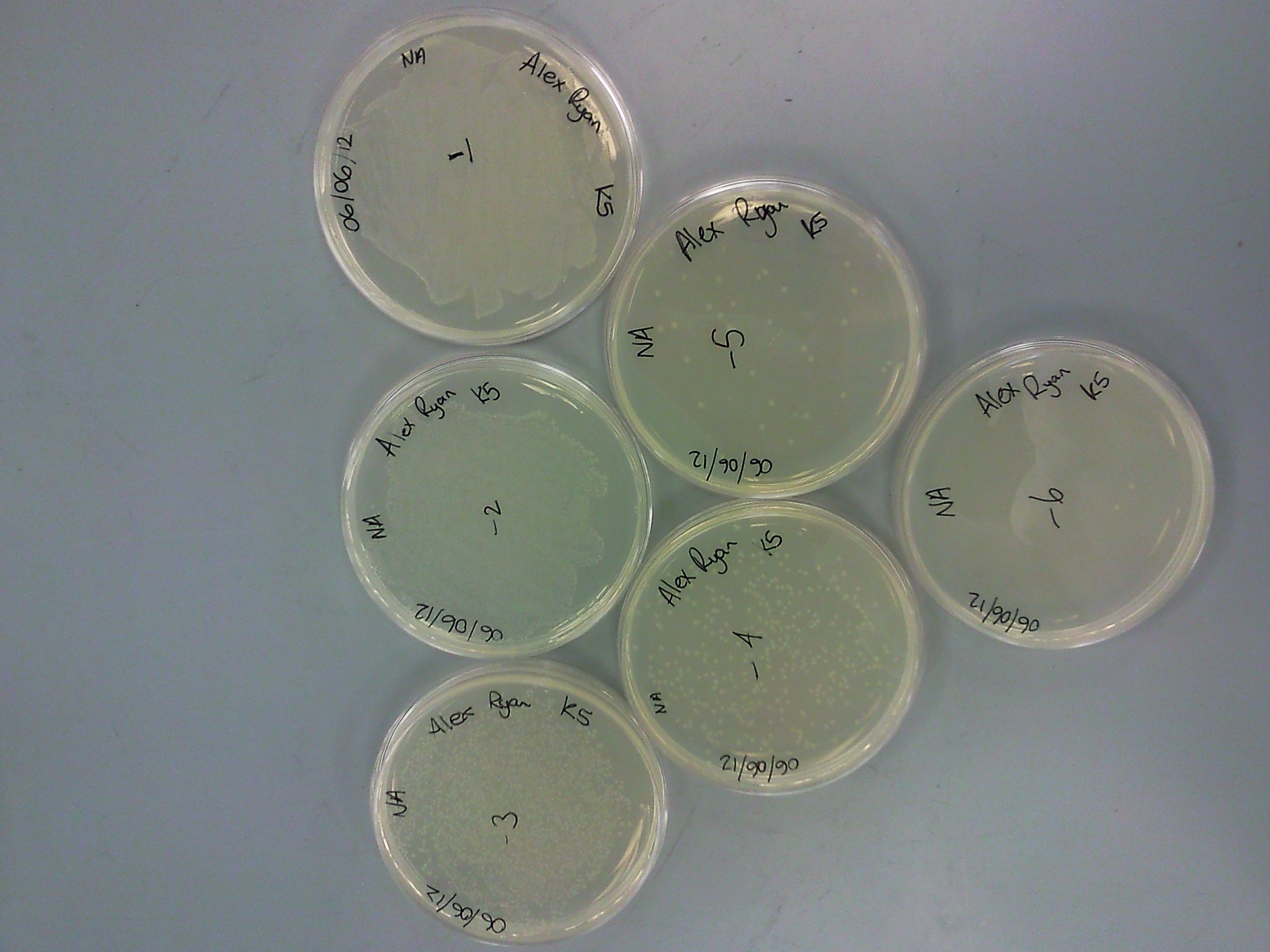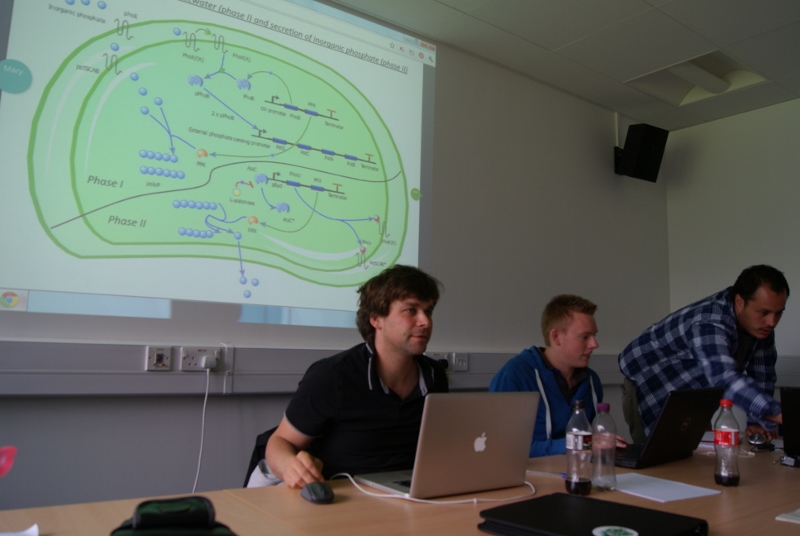Team:Exeter/Notebook
From 2012.igem.org
| Home | Team | Official Team Profile | Project | Parts Submitted to the Registry | Modeling | Notebook | Safety | Attributions |
|---|
The story so far...
The first three weeks of the project have been set aside to obtain a general biological background, particularly useful for the non-biologists in the team! This will be achieved through several short lectures, discussions and practical laboratory sessions. Project ideas will be put forward with the aim of making the final decision on Thursday 14th June. The subsequent ten weeks are set aside for the project to be developed.
WEEK ONE
28th May 2012
The team arrived and Tom (the project coordinator) started us off with an introduction to the iGEM competition, shortly followed by John Love giving a talk on synthetic biology. Tom got everyone up to scratch on basic biology (central dogma etc). Orkun Soyer (mathematician) gave a talk on biostability and then Christine Sambles gave an overview of the -omics.
29th May
Clive Butler talked about Thauera selenatis and microbial nano-material synthesis. Nick Smirnoff spoke on metabolic engineering and then Nic Harmer on polysaccharides. The afternoon session was set aside for brainstorming.
1st June
Today's lecturers:
- Tom- biofuel production.
- George Littlejohn- biosensors and reporters.
- Rob Beardmore (Biosciences)-dynamical systems modelling.
- Peter Petrov (Physics) - bacterial swimming and artificial swimmers.
The afternoon session was spent brainstorming, below are a selection of some of the ideas:
WEEK TWO
6th June
Initial lab induction with an in depth health and safety talk. Basic lab techniques were practiced, such as gel preparation and creating single colonies, see photograph insert for the very respectable results from a Physicist!
7th June
The second day of lab work- we isolated the DNA and then separated the DNA fragments using Gel Electrophoresis. The estimated sizes were then mapped and compared to expected maps.
8th June
Through many hours of brainstorming and discussion over the past two weeks the team has managed to single out a short-list of five strong ideas for the project which were presented to a range of relevant academics.
- Phosphate Collection- through synthetically modifying an organism the uptake of phosphates may be significantly increased.
- Polysaccharide synthesis - designer sugars. Creating a biological toolkit with which houses many material and medical applications.
- One-cell cellulose degradation - 'pac-man'. Find commonality for three types of cellulases and affix to scaffold. Could have transfer sequence to cell exterior.
- Logic-gated 'thinking' bacteria - improve on what has already been done somehow. Should work at level of proteins, not genes, for instant response.
- Biological ionising radiation detector- a method of detecting the strength of Gamma, X-ray and UV waves through their energy output.
After further discussion, two ideas were taken forward to next week...Polysaccharide synthesis and Phosphate Collection.
WEEK THREE
11th-15th June
Throughout the week we've all been super busy researching for the final presentation of our two ideas. We had to get our designs up to scratch for the scrutiny of a range of professors and researchers who really know their stuff! Our two final ideas:
- Phosphantastic- Phosphate supplied are going to deplete within 30 years, and with 2/3rd of the world population relying directly upon Phosphate-based fertiliser... we feel it is a very important issue to tackle. The premise being through Synthetic modification we can create a two phase process where by the cell, in response to a promoter, uptakes way more Phosphate than would naturally occur. The second phase looks at excreting the phosphate ready for collection.
- Sweet Shop- A Polysaccharide catalogue which will eventually allow designer materials to be created, for example a polymer with strength x which yields at y. This idea, albeit a colossal challenge, if successful will change the outlook on Synthetic Biology and Materials Engineering.
Both ideas are especially strong and most students changed their minds multiple times before the day was up. After an anonymous vote ....SWEET SHOP is our project for the summer! We're all very excited about getting started....but before then, time for a relaxing game of pool!
Our project abstract: Our aim is to design a system for the bespoke synthesis of polysaccharides in Escherichia coli (E. coli). Our objectives are two-fold, 1. to engineer E. coli to synthesise novel polysaccharide(s) designed by us, and 2. to construct an engineered plasmid which will allow the differential expression of enzymes, producing the polysaccharides chosen depending on the stimulus of particular promoters; this grants a controlled external selection mechanism to the polysaccharide production of the cell. Furthermore we are developing software tools to facilitate the selection of polysaccharide synthesising enzymes and are proposing a new, rapid design-model-analysis workflow for polysaccharide characteristisation and exploitation.
The ultimate goal of this engineering process is to demonstrate the production of desired polysaccharides and to provide a mechanism by which polysaccharides can be produced 'to order'. The applications for this are enormous, for example, vaccines could be produced at speed and material scientists and engineers would be able to choose a synthetic polysaccharide fulfilling desired properties.
Why did we choose the project?
Novel Polysaccharide Synthesis will revolutionise the way we can design intelligent materials. Nature goes to a lot of trouble to synthesise specific sugars to regulate cellular properties (e.g. osmotic pressures). We are synthetically bridging the gap between natures fine design of polysaccharide based materials to what we can humanly achieve. We are proposing a mechanism by which we may fine tune adjustments to polysaccharide structures to influence the macro properties of a certain sugar.
Is being able to synthesise such precise polysaccharides important? Indeed! To name just a few of the novel applications; by changing chain length of polymers we can design special viscous liquids for non-drip paint, we could tune a specific cartilaginous polysaccharide for lubricants, rapid/safe vaccines could be produced from a database of designer sugars.
By forming a method of synthesising sugar chains in this manner, there is a possible myriad of presently inconceivable applications due to the wealth of new sugars, previously unseen in nature, which we would offer. Thus allowing for the basis of a completely unique designers toolkit.
We will create a database of well characterised glycosyltransferases. We envisage the design of a synthetic E. coli containing this information which, providing a system relating glycosyltransferases to certain output sugars, would be a factory of designer sugars. A final aim would be to link such a system to output specific ‘material properties’ for the E. coli to produce.
Our system is at the forefront of emerging technologies and it has potential to work efficiently because we are playing by the same rules as nature. The design, biological, engineering and medicinal uses are limitless which is why our project is exciting for such a range of people.
WEEK FOUR
18th-22nd June
Project planning began with a huge whiteboard and tonnes of enthusiasm. It's a tall order to try and organise a ten week project between ten students from different backgrounds, but we're working on it!
A few of the group members began developing their coding knowledge and started working on the wiki page. It was amazing to see that within a few days so much could visually change for the project. Through meeting a graphic designer, we created a new logo and re-branded our project with the name, E-Candi.
Press-relations were considered and an outreach program began with creating a Polysaccharide-based dominoes game which we can use to teach school children about our idea, and to inspire them to continue studying science. A Cafe Scientific session was organised for September to discuss both the project, as well as Synthetic Biology on a whole.
Taking care not to neglect the Biology- 120 Glycosyltransferases were created and added to the database. The design of how the biological system will work was produced.
"An Introduction to Systems Biology- Design Principles or Biological Circuits" by Uri Alon was read from cover to cover to help with the modelling processes. The regulatory genetic network plasmid design was created through Tinkercell, with a view to have greater control over enzyme expression.
WEEK FIVE
A meeting kicked off the week to find out where everyone is at within the project and to set targets for the week ahead.
The colossal list of 120 Glycosyltransferases has been reduced to only 20.
The Polysaccharides database plan began with a diagram of how the system works. The team discussed many different methods for implementing the database.
Novel uses for the Polysaccharides were considered-
- Cotton is made from Polysaccharides but is currently produced in very damaging ways.
- Cotton farming accounts for 8-10% of the worlds pesticide use and in developing countries this is up to 50%. The WHO says that there are several million cases of pesticide poisoning each year related to cotton causing between 20,000 and 40,000 deaths.
- Cotton farming accounts for 8-10% of the worlds pesticide use and in developing countries this is up to 50%. The WHO says that there are several million cases of pesticide poisoning each year related to cotton causing between 20,000 and 40,000 deaths.
- To obtain about1 kg of cotton lint, which is about enough for a pair of jeans, 8500 litres of water is required. That is 40 baths worth of water for one pair of Levis.
- To obtain about1 kg of cotton lint, which is about enough for a pair of jeans, 8500 litres of water is required. That is 40 baths worth of water for one pair of Levis.
- Due to irrigation of cotton the Aral sea has decreased in size by 85% over the last 40 years leading to the destruction of ecosystems and biodiversity and the extinction of at least 24 native fish species. Due to cotton cultivation habitats are being destroyed all over the world. On top of all this the cotton industry is guilt of terrible working conditions for human beings. The India Committee of the Netherlands reported that nearly 450,000 children between six and 14 were employed in cotton fields in India during 2003-04.
- Due to irrigation of cotton the Aral sea has decreased in size by 85% over the last 40 years leading to the destruction of ecosystems and biodiversity and the extinction of at least 24 native fish species. Due to cotton cultivation habitats are being destroyed all over the world. On top of all this the cotton industry is guilt of terrible working conditions for human beings. The India Committee of the Netherlands reported that nearly 450,000 children between six and 14 were employed in cotton fields in India during 2003-04.
- Grow-your-own-bridge-
Hydrophobic domains repel the presence of water creating a bridge over water masses. Hopefully I won't be the first person to walk across it!
- Warm Wetsuit- incorporate Zylomannan (found in Alaskan Beatles) can be incorporated into wetsuit design to increase the temperature of the user.
- Pressure Equaliser- using Hyaluronan to repel the pressure to assist divers whom may encounter discomfort.
After many tireless nights, the wiki became live on Thursday evening! A very excited day!
We met with Ed Creed, a marketing executive from the University to help us advertise the project, as well as iGEM. We're looking forward to having many more hits onto the website.
 "
"


